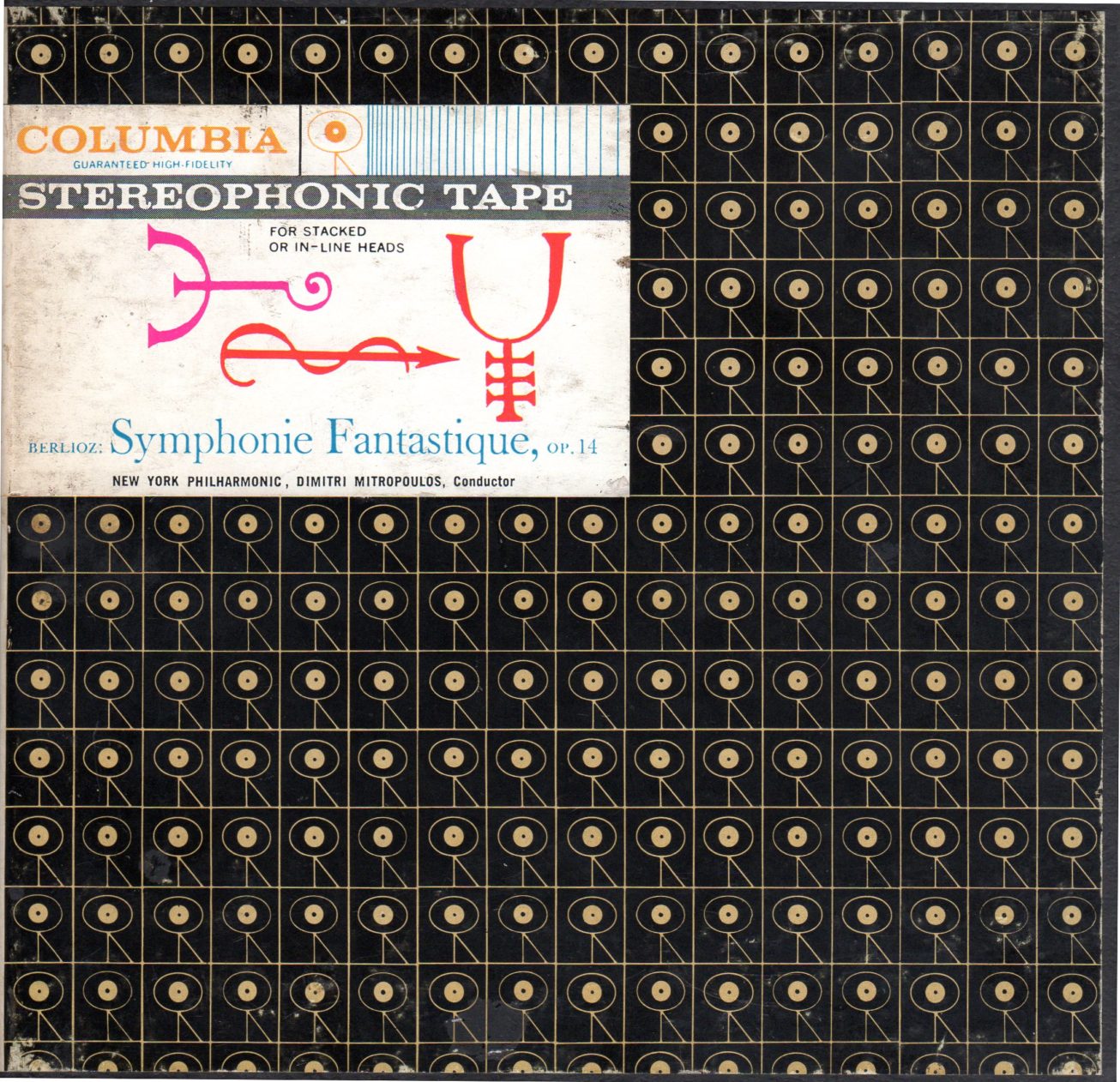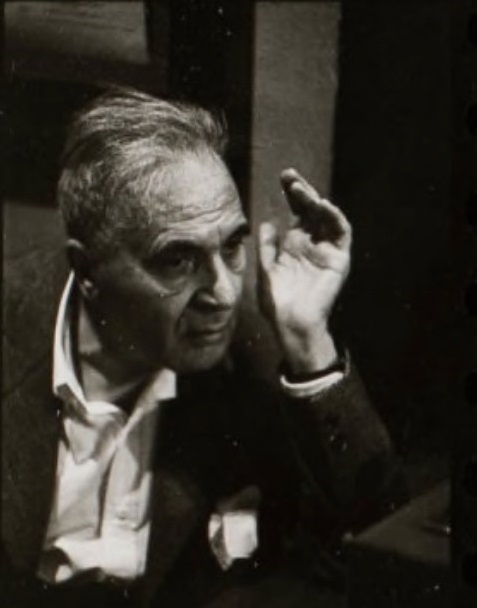
Rudolf Serkin – Dimitri Mitropoulos NYPO
Carnegie Hall – October 23, 1955
Source: Bande/Tape 19 cm/s / 7.5 ips
Pour les concerts de gala (avec de nombreux invités) fêtant la rentrée de l’orchestre après une longue tournée européenne (3 septembre – 7 octobre 1955), Rudolf Serkin et Dimitri Mitropoulos ont joué les 20 & 21 octobre 1955 trois Concertos de Mozart, successivement le n°25 K.503, le n°16 K.451 donné pour la première fois avec le NYPO, et le n°23 K.488. Les critiques ont été éminemment favorables, mais plusieurs ont remarqué que, si, quand le pianiste jouait, l’orchestre était réduit à de justes proportions mozartiennes, par contre, l’orchestre seul jouait avec le plein effectif de cordes, engendrant dans les tutti lourdeurs, problèmes d’équilibre et excès de dynamique.

Le plein effectif des cordes avec ses neuf contrebasses! (P-H Lang N-Y Herald Tribune Oct.21,1955)
Des critiques ont souligné que, pour un tel concert d’ouverture, le chef n’aurait pas pu faire autrement qu’employer ce plein effectif.

Le programme du concert radiodiffusé du dimanche 23 ne retenait que les Concertos n°16 & 25, mais s’ouvrait par la Sinfonia Concertante « K. Anh.104 » de Mozart:

Sunday Afternoon Broadcast with only two Concertos played by Rudolf Serkin
For the gala opening concerts (with many guests) to celebrate the orchestra after its long European tour (September 3 – October 7, 1955), Rudolf Serkin and Dimitri Mitropoulos performed three Concertos by Mozart on October 1955, 20 & 21, successively n°25 K.503, n°16 K.451 (first performance with the NYPO), and n°23 K.488. The critics were quite favourable, but several of them remarked that, if in solo passages, the orchestra had the size of a Mozart ensemble, however the orchestra alone performed with a full complement of strings, thus with problems of heaviness, balance shifts and excessive dynamics in tutti. Critics underlined that, for such an opening concert, the conductor could not do otherwise than to display the full body of strings. Of these, only Concertos n°16 K.451 and n°25 K.503 were played at the Sunday Afternoon Broadcast concert, which opened with Mozart’s Sinfonia Concertante « K. Anh.104 ».

Les liens de téléchargement sont dans le premier commentaire. The download links are in the first comment.

n°4 Op.18 n°4 – Moscou Petite Salle du Conservatoire 13 mars 1960 Cycle Beethoven 3ème concert
n° 10 Op.74 – Moscou Petite Salle du Conservatoire 13 avril 1960 Cycle Beethoven 4ème concert
n°16 Op.135 – studio 12 juin 1952
Dmitry Tsyganov, violon I, Vassily Shirinsky, violon II, Vadim Borisovsky, alto et Sergei Shirinsky, violoncelle
Au cours de la saison 1959-1960, le Quatuor Beethoven a donné dans la Petite Salle du Conservatoire de Moscou un cycle de quatre concerts dédiés à des Quatuors de Beethoven, à savoir le 31 octobre 1959 (concert I) Quatuors n°1 Op.18 n°1 et n°7 Op.59 n°1; le 13 décembre 1959 (concert II) Quatuors n°2 Op.18 n°2 et n°15 Op.132; le 13 mars 1960 (concert III) Quatuors n°4 Op.18 n°4 et n°14 Op.131 et enfin le 13 avril 1960 (concert IV) Quatuors n°10 Op.74 et n°13 Op.130. De ces concerts, ont subsisté des enregistrements des Quatuors n°4 Op.18 n°4 et n°10 Op.74. Ils ont été publiés au Japon en 1995 dans un coffret Triton de 7 CD (MECC 26-018-26024) qui est devenu introuvable et ces enregistrements ne sont pas accessibles autrement. Ils nous permettent d’écouter le Quatuor Beethoven jouer Beethoven en concert dans sa formation d’origine.
Dmitry Tsyganov était célèbre pour son interprétation dionysiaque voire diabolique du vigoureux et virtuose passage en arpèges du premier violon qui intervient peu avant la coda du premier mouvement du Quatuor n°10 Op.74 dit « Les Harpes ». Cet enregistrement permet de fixer ce moment unique, bien mieux que la version de studio qui date de 1972.


L’enregistrement du Quatuor n°16 Op.135 provient d’un autre CD, publié en France en 1991 par la firme Vogue (VG 651027). Il s’avère en tous points supérieur au microsillon Melodiya D8023-8024 publié en 1961, dans lequel l’ajout d’une réverbération excessive donnait une apparente plus-value sonore, mais dénaturait l’interprétation.
Il existe dans plusieurs Radios allemandes (Köln, Frankfurt, Bayerische Rundfunk) ainsi qu’à la Radio de Kiev d’autres enregistrements du Quatuor Beethoven dans sa formation d’origine. Espérons que ceci intéressera un éditeur. On peut penser notamment à Meloclassic qui a publié beaucoup d’archives, en particulier de musique de chambre, provenant de Radios allemandes.
________________
During the 1959-1960 season, the Beethoven Quartet gave in the Small Hall of the Moscow Conservatory a cycle of four concerts comprised of Quartets by Beethoven, namely on October 31, 1959 (concert I) Quartets n°1 Op.18 n°1 and n°7 Op.59 n°1; on December 13, 1959 (concert II) Quartets n°2 Op.18 n°2 and n°15 Op.132; on March 13, 1960 (concert III) Quartets n°4 Op.18 n°4 and n°14 Op.131 and to end with, on April 13, 1960 (concert IV) Quartets n°10 Op.74 and n°13 Op.130. From these concerts, recordings of Quartets n°4 Op.18 n°4 and n°10 Op.74 have survived. They have been published in Japan in 1995 in a « Triton » 7 CD boxset (MECC 26-018-26024) that is long out of print and these recordings are not available otherwise. They allow us to hear the Beethoven Quartet play Beethoven live with their four original members.
Dmitry Tsyganov was famous for his dionysiac and almost diabolical performances of the vigourous and virtuoso « arpeggio » sequence of the first violon which comes shortly before the coda of the first movement of Quartet n°10 Op.74 « Harp ». This recording allows to perpetuate this unique moment, much better than the 1972 studio version.
The recording of Quartet n°16 Op.135 comes from another CD, published in France in 1991 by Vogue (VG 651027). It is vastly superior to the Melodiya LP D8023-8024, published in 1961, in which an excess of added reverb gave a flattering sound but almost fatally marred the performance.
In several German Radios (Köln, Frankfurt, Bayerische Rundfunk) as well as the Kiev Radio, there exist other recordings of the Beethoven Quartet with its four original members. Let’s hope a record company will be interested, e.g. Meloclassic which published many archive recordings, a.o. of chamber music, from German Radios.
Les liens de téléchargement sont dans le premier commentaire. The download links are in the first comment.

Dimitri Mitropoulos New York Philharmonic
Columbia 30th Street Studios – 24 février 1957
Bande 19 cm/s 2 pistes (7.5 ips ; 2 tracks) OMB – 6
Nous poursuivons cet Hommage à Dimitri Mitropoulos (1896-1960) à l’occasion du 125ème anniversaire de sa naissance. D’ici la fin de l’année, quatre autres publications vont suivre.
Février 1957, c’était pour Columbia le début de la stéréo. Le 18 février Bruno Walter commença à Carnegie Hall l’enregistrement de la Deuxième Symphonie de Mahler qu’il ne pourra terminer que l’année suivante. Pour cette Symphonie Fantastique, nous sommes dans les Studios Columbia de la 30ème rue, une ancienne église arménienne, qui a été utilisée depuis fin 1948 pour un très grand nombre d’enregistrements de musique de chambre et d’orchestre. La prise de son stéréophonique, très soignée, assume une esthétique sonore qui vise au spectaculaire, ce qui fonctionne parfaitement avec cette œuvre. L’interprétation, comme toujours très personnelle, de Mitropoulos est une réussite. Notons que le chef l’avait donnée au concert à Carnegie Hall les jeudi 21 et vendredi 22 février, et l’enregistrement a été réalisé le dimanche 24.




Disposition de l’orchestre à Carnegie Hall (saison 1956-1957)
We go on with this Tribute to Dimitri Mitropoulos (1896-1960) for the 125th Anniversary of his birth. Until the end of this year, four more posts will follow.
February 1957 was for Columbia the beginning of Stereo. On February 18, Bruno Walter began in Carnegie Hall the recording of Mahler’s Second Symphony which he was able to complete only the following year. For this Symphonie Fantastique, we are in the Columbia 30th Street Studios, a former Armenian church, which was used since the end of 1948 for a very large number of chamber music and orchestral recordings. The stereophonic recording, very carefully done, displays a chosen sound spectacular aesthetics, which matches this work perfectly well. The performance, very personnal, as always with Mitropoulos, is a winner. Note that the conductor performed it at Carnegie Hall on Thursday 21 and Friday 22, and the recording was made on Sunday, the 24th.
Les liens de téléchargement sont dans le premier commentaire. The download links are in the first comment.
Artur Schnabel, piano; Alphonse Onnou, violon; Germain Prévost, alto,
Robert Maas, violoncelle, Claude Hobday, contrebasse
London Abbey Road Studio n°3 – November 16, 1935
Engineer: Edward Fowler

Artur Schnabel et les membres précités du Quatuor Pro Arte (biographie par Anne van Malderen) ainsi que le contrebassiste Claude Hobday (1872-1954) ont enregistré ce quintette « La Truite » en 1935, mais la qualité sonore de cet étonnant microsillon japonais EMI-Toshiba GR-2020 du milieu des années soixante, gravé à partir de reports effectués à Londres par Anthony Griffith, donnerait plutôt à penser qu’il a été enregistré bien plus tard. L’explication est d’une part la prise de son du magicien Edward Fowler et d’autre part que l’on est en présence d’une copie directe et sans traitement de pressages vinyles effectués à partir de matrices métalliques de qualité exceptionnelle.
_______________
Artur Schnabel and said members of « Quatuor Pro Arte » (biography by Anne van Malderen) together with double-bass player Claude Hobday (1872-1954) have recorded this « Trout Quintet » in 1935, but the sound quality of this astonishing Japanese LP EMI-Toshiba GR-2020 from the mid-60s, cut from transfers made in London by Anthony Griffith would rather suggest a much later recording date. The explanation is on the one hand the sound captured by the magician Edward Fowler and on the other hand that this is an unprocessed transfer from vinyl pressings made from exceptionally clean metal parts.

Alphonse Onnou, violon

Robert Maas, violoncelle & Germain Prévost, alto



Les liens de téléchargement sont dans le premier commentaire. The download links are in the first comment.

New York Philharmonic Bruno Walter
Carnegie Hall – 24 Janvier 1954
Source: Bande/Tape 19 cm/s / 7.5 ips

Bruno Walter a dirigé plusieurs fois cette symphonie avec le NYPO, et ce dès 1924 (les 28 et 29 février). Il la dirigea de nouveau en octobre 1933 (les 12, 13, 14, et 15), en octobre 1942 (les 22, 23, 24 et 25), en février 1950 (les 9, 10 et 12) et enfin une seule et unique fois en 1954, pour le concert radiodiffusé du dimanche 24 janvier depuis Carnegie Hall, suivi le lendemain par l’enregistrement pour Columbia dans cette même salle (plutôt que dans l’ habituel « Columbia 30th Street Studio »). Le concert public est plus vivant que sa contrepartie pour le disque. On remarque, à l’écoute de l’enregistrement du concert, une certaine sécheresse de l’acoustique de Carnegie Hall, que l’on ne perçoit pas dans la salle vide où le disque a été capté.

Bruno Walter conducted several times this symphony with the NYPO, as early as 1924 (February 28 and 29). He conducted it again in October 1933 (12, 13, 14, and 15), in October 1942 (22, 23, 24 and 25), in February 1950 (9, 10 and 12) and only once and for the last time in 1954, for the Sunday broadcast Concert of January 24 from Carnegie Hall, followed on the next day by the recording for Columbia in the same venue (rather than the usual « Columbia 30th Street Studio »). The live performance is more lively than its disc countertpart. When listening to the broadcast concert, one notes some dryness in the acoustics of Carnegie Hall, not to be found in the empty hall where the disc has been recorded.
Les liens de téléchargement sont dans le premier commentaire. The download links are in the first comment.



